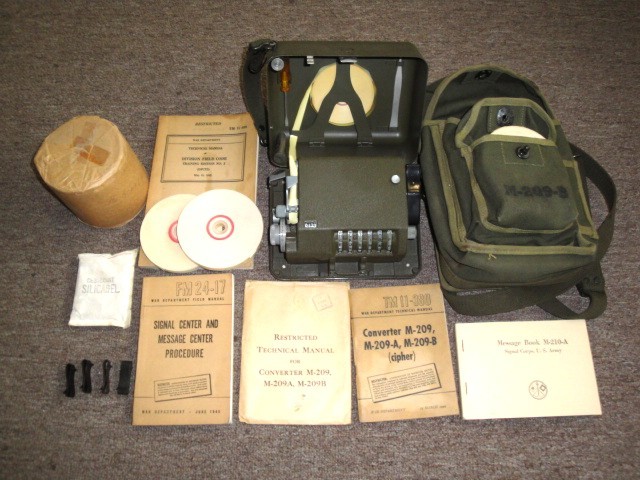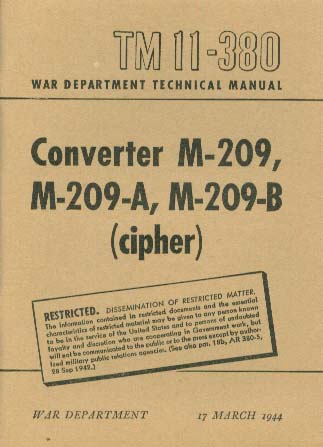M-209 (original) (raw)
M-209 (CSP-1500)
The CSP-1500 (M-209 in US Army nomenclature) was a portable, hand-operated, tape-printing mechanical device designed for encipherment and decipherment of tactical messages. Its cryptographic principle is that of reciprocal substitution alphabets, achieving the effect of sliding a standard alphabet sequence against a standard reversed alphabet sequence. This is achieved by means of a train of gears in which the number of active teeth on the driving member is varied in accordance with prearranged settings of the keying elements, a high degree of irregularity is effected in the shifting of each alphabet against the other. The unit's mechanism has a cryptographic period of 101,405,850 letters before repetition.
This machine was developed as a replacement for the CSP-885 (M-94) for use in tactical situations. It is derived from a machine created by Boris Hagelin in Sweden during the late 1930's. In 1940, several machines were purchased by the Army Signal Corps. Mass production of the machine began in the United States after the design was simplified and the mechanics were made more rugged. Its first general use was during the African invasion in November 1942. Smith-Corona built approximately 125,000 at $64.00 each and was discontinued in the early 1960�s [2].
The M-209 was popular in the Army because it was small, light, and operator could be trained in just a few hours. No special security was required for the machine itself. However, it was never cryptographically secure so it could only be used on low level, tactical traffic where it only needed to delay an enemy decipherment by a few hours. The Army and Navy used the same keying and operating procedures for the CSP-1500 and the M-209.
In mid-1964, the United States supplied M-209 cryptomachines to RVN and ROK forces for use at battalion level, and in January 1965 it distributed the AN-series operations code for encryption at any echelon (replacing the SLIDEX device). [1]
Mark Sims writes "The M209 (and other Hagelin machines) uses the letter "Z" as a substitute for the SPACE key. You encode all spaces as "Z" and when the machine decodes a "Z" it prints a space. Many of the machines also have a setting to treat "Z" as a normal letter. Also, I know the Italian versions of the machines use "K" for this since Italian does not use the letter "K"... My BC-543 came from Italy".
SPECIFICATIONS:
Weight: 6 pounds.
Average speed: 30 characters per minute.The US Army released 300 M-209s to the National Cryptologic Museum, with permission that the Museum could use them for trade to acquire items of interest for their collection. It is believed that M-209's were never "classified" as a security item.
REFERENCES:
This information was provided from the USS Pompanito web page. Excerpts from:
1) Plans for R and D Crypto Equipment. Available from NARA; NSA Historical Collections 190/37/7/1, NR 3288 CBOM71 16503A 19440909.
2) Maintenance Instructions For Converter M-209-A.
IDENTIFICATION
M-209 Markings
SC= Source Control
SCD= Source Control Document or Source Control Drawing
CACH in serial number area of name plate was the USN manufacturers code for L.C. Smith-Corona Typewriter
Developed by Boris Hagelin, a Swedish inventor, the M-209 was adopted for American use as a tactical cipher machine in 1942. It provided security in both World War 2 and Korea. (Photo by Jerry Proc)
 |
|---|
| This is a complete M209-B Code Converter Set circa 1944. (Photo via E-bay) |
 |
|---|
| The M209 cipher machine, developed from the C38 of Boris Hagelin, was built under license by Smith & Corona in the USA and thousands were built for use during WWII.This M-209 example is on display in the National Cryptologic Museum. (Photo by Jerry Proc) |
M209 case. (Photo courtesy john@astory.com ; Baltimore, Md).
M209 Handbook. (Photo via E-bay) Accodring to George Mace, there are four known versions of the manual:
TM 11-380
33 PAGES
WAR Department Technical Manual
Converter M-209
April 27, 1942
San Francisco National Park Association Website
This is a readable HTML network format version of this manual.
http://www.maritime.org/csp1500inst.htmTM 11-380 B
42 PAGES
WAR Department Technical Manual
Converter M-209 B
20 Sep 1943TM 11-380
78 PAGES
WAR Department Technical Manual
Converter M-209, M-209A, M-209 B (Cipher)
17 March 1944
Paragraph on title page states "This manual supersedes TM 11-380, 27
April 1942, and TM 11-380 B, 20 September 1942".
Bob Lords Website. Bob presents a down loadable JPG version of this
manual. http://www.ilord.com/m209manual.htmlTM 11-380
170 PAGES
Converter M-209, M-209A, M-209B (Cipher)
May 1947 (Updated 10 April 1951)
Illustrated with five chapters:
*Introduction
*Operating Instructions
*Preventive Maintenance
*Auxiliary Equipment
*Repair Instructions
* Six Appendices
Another version of the M-209 message book. (Photo via E-bay)
A M-209 oiler tube which holds lubricating oil and an applicator.. Approximately 6 cm by 1 cm, the cap is marked with a large �O�. (Photo by John Alexander, G7GCK).
ATTENTION - M209 COLLECTORS
1) For collectors who exercise their M-209 regurarily and need a new ink roller, I suggest the following:
DREMEL power tools has a #422 felt polishing tip made of very dense material. I removed the brass shaft from my old ink roller, cut the polishing tip to fit and inserted the shaft, which fit perfect. Although this new ink roller is slightly larger in diameter, it works very well!
3) Mark Sims offers his advice for M209 ink rollers. "Another useful bit of info for M-209/CX-52/C-446/BC-543 users is a good source of ink rollers for the machines. Most office supply stores carry the NuKote NR-40P ink roller for calculators. It is also numbered EA770R, CP-16, or IR-40 by other manufacturers. It is used by over 100 different calculators.
The ink element is the exact inside and outside diameter as the M209/CX52/BC543 ink roller, but about 1/8" longer. It is very easy to modify the calculator roller for use with the cipher machines. Wear gloves, it's incredibly messy and the roller gushes ink at the slightest provocation.
First snap the roller/axle out of the "U" shaped clip. Next take the roller off of the axle. I have found it easiest and cleanest to cut the end of the axle off first. I use a pair of diagonal wire cutters. Next trim the roller with a razor blade or surgical scissors to 3/8" long. I have found it easiest to get a clean square cut with the surgical scissors. Finally the roller needs the small brass axle from a real roller or you can cut one off of a piece of 3/32" O.D. brass tubing from a hobby shop".
Mark Sims <holrum(at)hotmail.com>
Footnotes:
[1] National Security Agency: Working Against the Tide (COMSEC Monitoring and Analysis), Parts 1 and 2 by Donzel E. Betts, June 1970
[2] United States Cryptologic History, Series VI the NSA Period 1952-Present, Volume 5, American Cryptology During the Cold War, 1945-1989, Book I; The Struggle For Centralization, 1945-1960, Thomas R. Johnson, Center for Cryptologic History, National Security Agency, 1995
Reference page 213 of the document.
Credits and References:
1) Mark Sims <holrum(at)hotmail.com>
2) George Mace <gmace8(at)comcast.net>
3) R.C. Blankenhorn <rcb(at)gemmary.com>
4) John Alexander <jacrypto(at)gmail.com>
Jan 13/14






